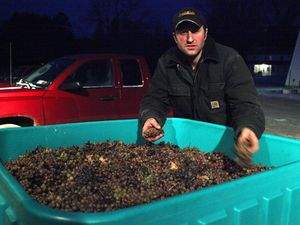
By Bryan Calandrelli, Niagara Region Editor
The landscape along the Lake Ontario shoreline-hugging roadway that stretches eastward to Orleans County – Route 18 – pretty much becomes desolate once you pass Olcott. And it only seems more desolate at four in the morning on the coldest day of the winter. Lyndonville’s distance from the center of the Niagara Wine Trail keeps me from making this journey as often as I’d like to, but on this morning there was no hesitation – it was Leonard Oakes Estate Winery’s annual ice wine harvest.
As I made my way through an apple orchard to the first few rows of grapevines in the dark of night, there wasn’t much that would indicate that this was one of the most important days of the year for winemaker Jonathan Oakes, who had been waiting for this day since bud break.
“I don’t feel relaxed until these grapes are off and we’re in with a long enough window to press it out and work with it,” said Oakes.
It was only after hearing the low rumbling tractor noise and following the faint glimmer of headlights at the opposite end of the pitch-black vineyard that I found the winemaker surrounded by a few winery staff and an army of volunteers.
“Can you see the look of relief in my face?” asked Oakes.
 While many wineries have already celebrated the end of harvest with toasts and parties, a few Niagara region wineries don’t consider the season to be over until their vats are full of ultra-sweet vidal blanc juice.
While many wineries have already celebrated the end of harvest with toasts and parties, a few Niagara region wineries don’t consider the season to be over until their vats are full of ultra-sweet vidal blanc juice.
With this winter’s unusually mild temperatures, the thought of a normal ice wine harvest seemed like wishful thinking. Yet Oakes reassured me that the weather window we were in was perfect, even going as far as to state that this was the easiest winter harvest for the winery since they started. The lack of snow accumulation in the vineyard made getting the tractors, equipment and people in easier and the huge amount of support they received from volunteers enabled them to get the grapes off the vine in record time.
“During the last couple of harvests, the idea of ice wine was new to our area and it was difficult to recruit people that would be willing to get out there and help,” said Oakes. This year things were different. “All the recent accolades and buzz about our ice wine has really helped to secure people that want to come out and participate,” he said.
It’s this excitement and interest, combined with the fact that the Niagara region has already proven it can consistently produce some of the world’s best ice wine, that leads Oakes to believe that the industry has a strong future in his backyard.
“I look at the amount of plantable acres we have left, with a grape variety like vidal that can grow in a little more severe conditions, and I think there’s just unlimited potential in our area,” said Oakes.
 Even in mild winters like this one. Mother Nature ends up delivering what local winemakers need. And while Niagara is certainly not the only region to produce this style of wine, it does benefit from the success of Ontario’s ice wine industry. Niagara USA needs only to look at their example across the river on how to distinguish itself from the rest.
Even in mild winters like this one. Mother Nature ends up delivering what local winemakers need. And while Niagara is certainly not the only region to produce this style of wine, it does benefit from the success of Ontario’s ice wine industry. Niagara USA needs only to look at their example across the river on how to distinguish itself from the rest.
“It’s going to rely heavily on who jumps out and makes a distinct claim as to what is what our region can be known for,” said Oakes.
Regional branding aside, it’s in the post-harvest moment where I’m standing around with the rest of the crew warming up appropriately enough with a glass of Canadian whisky celebrating an end to a frigid end of the season harvest where I get a feeling of how special ice wine is to have gotten so many people to brave the elements just to take part in its production.
As daylight broke leaving Lyndonville, my journey back home was not as isolated as the trip there. I noticed a few carloads of vineyard workers following me back to Burt, NY where Schulze Vineyards & Winery had just begun their own harvest.

